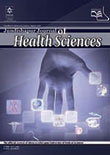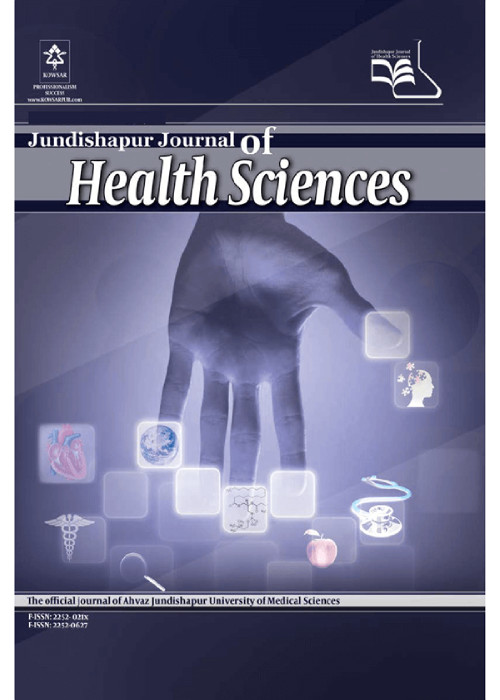فهرست مطالب

Jundishapur Journal of Health Sciences
Volume:7 Issue: 3, Jul 2015
- تاریخ انتشار: 1394/06/22
- تعداد عناوین: 8
-
-
Page 1BackgroundApplication of ionizing radiation in many fields especially in medicine is growing, and can cause adverse health effects..ObjectivesThe current study aimed to evaluate the radiation protection principles in radiology departments, based on national standards..Materials And MethodsThe current study was conducted in all radiology departments of the teaching hospitals in Ahvaz, Iran, and their radiation protection status was investigated using Audit technique. For this purpose Audit checklist was prepared and essential information gathered by observation, interview with radiology department managers, and documentary surveying. At the end, standard situations were classified in three levels: poor (˂ 50%), medium (50 - 75%),s and good (75 - 100%)..ResultsThe mean of radiation protection in the studied radiology departments was 70.53%. The highest and lowest levels of radiation protection were in quality control and suitable ventilation, respectively. Radiation protection was evaluated as medium in 71.4% and good in 28.6% of the studied radiology departments..ConclusionsThe state of observed radiation protection principles was relatively in the weak level in the studied radiology departments especially in facilities such as ventilation system, radiography entrance, and darkroom situation. More important reason was usage changing of sections as radiology billet from related organizations..Keywords: Radiation Protection, Radiology Department, Hospital, Ionization Radiation
-
Page 2BackgroundHearing loss is developing when age is rising. Initiation and progression rates of hearing loss vary among different individuals and groups..ObjectivesThe current study aimed to determine satisfaction of the elderly with their hearing aids in different types of hearing loss and comorbidities..Patients andMethodsThe study was conducted on 40 elderly subjects suffering from hearing loss and using hearing aids. The data collection method included assessment of hearing loss in addition to using a questionnaire to estimate respondents'' satisfaction with their hearing aids in daily life. The Persian version of the Satisfaction with Amplification in Daily Life (SADL) questionnaire was administered. The data were analyzed using descriptive and inferential statistics by SPSS software version19..ResultsThe mean satisfaction scores of the elderly were 4.83 ± 0.51 and 5.36 ± 0.30 in the sensorineural loss groups. There was no significant difference between different comorbidities. There was a significant difference between satisfaction level of cost and services subscales in the symmetrical styles of hearing loss (P value = 0.04)..ConclusionsThe findings of the study indicated a high satisfaction of the elderly with their hearing aids, considering the type of hearing loss. Despite all the efforts to improve the audiologic services during verification process, the elderly should be consulted specifically in order to fit their hearing aid as well as their expectations from aid..Keywords: Satisfaction, Elderly, Hearing Loss, Comorbidity
-
Page 3BackgroundReliable water supplies for drinking and agriculture are some of the objectives for the sustainable development of every country. However, constructed facilities such as dams and irrigation networks and drainage can exert positive and negative effects directly or indirectly on the environment. The environmental impact assessment is a method for identifying the positive and negative effects caused by a plan and suggests performance management best practices aimed at lessening the negative impacts and augmenting the positive ones..ObjectivesThe present study sought to evaluate the environmental impacts of the water transfer project of the Jooban Dam in two phases of preparation and operation..Materials And MethodsA checklist containing the positive, negative, short-term, and long-term effects as well as the continuation and probable occurrence of these effects was used..ResultsThe results showed that the negative environmental and social impacts of the project outweighed the positive impacts in terms of type, number, and intensity..ConclusionsUnless there are well-thought out strategies for minimizing the undesirable impact on the environment, it is not advisable that such projects be permitted..Keywords: Environmental Impact, Water, Transfer
-
Page 4BackgroundSulfur dioxide is a colorless gas, released from burning of coal, high-sulfur coal,s and diesel fuel. Sulfur dioxide harms human health by reacting with the moisture in the nose, nasal cavity and throat and this is the way by which it destroys the nerves in the respiratory system..ObjectivesThe aim of this study was to focus on identifying the effects associated with sulfur dioxide on health in Ahvaz, Iran..Materials And MethodsData collections were performed by Ahvaz meteorological organization and the department of environment. Sampling was performed for 24 hours in four stations. Methods of sampling and analysis were according to US environmental protection agency (EPA) guideline. Afterwards, we processed the raw data including instruction set correction of averaging, coding and filtering by Excel software and then, the impact of meteorological parameters were converted as the input file to the AirQ model. Finally, we calculated the health effects of exposure to sulfur dioxide..ResultsAccording to the findings, the concentration of sulfur dioxide in Ahvaz had an annual average of 51 μg/m3. Sum of the numbers of hospital admissions for respiratory diseases attributed to sulfur dioxide was 25 cases in 2012. Approximately, 5% of the total hospital admissions for respiratory disease and respiratory mortality happened when sulfur dioxide concentration was more than 10 mg/m3..ConclusionsAccording to the results of this study, this increase could be due to higher fuel consumption, usage of gasoline in vehicles, oil industry, and steel and heavy industries in Ahwaz. The risk of mortality and morbidity were detected at the current concentrations of air pollutants..Keywords: Sulfur Dioxide, Health, Air Pollutants, Hemoglobin, Iran
-
Page 5BackgroundThe presence of natural organic matter (NOM) in raw water sources is unfavorable and has long been a problem for water supply industries. Natural zeolite is a low cost material that can be found in nature. Zeolite can be modified and used for removal of NOM from aqueous solutions..ObjectivesIn this study, for the first time, the efficiency of modified natural Iranian zeolite obtained from Semnan mines was investigated for removal of NOM from aqueous solution..Materials And MethodsIn this study, batch studies were set up to evaluate the effects of initial pH, contact time and also the initial NOM concentrations on adsorption behavior. The effective initial pH values were in acidic ranges for adsorption of the NOM by surfactant modified zeolite (SMZ). Kinetic studies showed that the adsorption of NOM by SMZ was a gradual process..ResultsThe batch kinetics experiments showed that NOM adsorption by the adsorbents followed the pseudo-second order model. Results showed that the acidic pH is optimum for adsorption of NOM by SMZ..ConclusionsThe findings of this study show that natural zeolite modified with sodium dodecyl sulfate, as a cationic surfactant, is a promising adsorbent for removal of NOM..Keywords: Natural Organic Matter, Adsorption Kinetics, Zeolites, Sodium Dodecyl Sulfate
-
Page 6BackgroundThe main method used for the laboratory confirmation of malaria is the conventional light microscopy; however, microscopy has three main disadvantages: I) it is time-consuming and labor-intensive; II) its results depend heavily on good techniques, reagents and microscopes; III) in many cases decisions about treatment are often taken without using the result of microscopy because of long delays in providing the results to the clinician. Hence, an extreme necessity of the fast automatic detection of the disease is required to diagnose and treat promptly..ObjectivesThrough the improvement of classification accuracy rate, this work aims to present a computer-assisted diagnosis system for malaria parasite..Materials And MethodsThis study was conducted using 400 confirmed images of blood slides infected with malaria parasite. The MATLAB software was used for the implementation of computation procedures. Using five extracted features (flat texture, saturation channel histogram, color histogram, gradient, and granulometry) and six classifiers (k-Nearest Neighbors (k-NN), 1-Nearest Neighbor (1-NN), decision tree (DT), Fisher, linear discriminant analysis (LDA), and quadratic discriminant analysis (QDA)), images were classified into two classes: parasitic and nonparasitic. Then, classifier fusion was done using several algorithms: mean, min, max, stack, median, Adaboost, and bagging..ResultsUsing six classifiers separately, the highest accuracy was obtained 92% using the k-NN classifier. The highest accuracy of the classifiers'' fusion was obtained using the Adaboost algorithm with 95.5% success rate..ConclusionsBy comparing the results of classification using multiple classifier fusion with respect to using each classifier separately, it is found that the classifier fusion is more effective in enhancing the detection accuracy..Keywords: Malaria, Classification, Decision Trees, k, Nearest Neighbor, Fisher, Adaboost, Multiple Classifiers Fusion
-
Page 7BackgroundLinear alkyl benzene sulfonates (LAS) are the most important ionic detergents that produce negative ions in the environment. These compounds enter surface waters through domestic and industrial wastewaters and cause environmental hazards..ObjectivesThe present study was aimed at assessing the performance of advanced sequencing batch reactor (SBR) in wastewater treatment plant of Yazd, Iran, to remove organic materials and detergents..Materials And MethodsThe present research was a descriptive longitudinal study conducted on 96 input and output samples of SBR system over eight months from October 2012 to June 2013. The studied parameters were biochemical oxygen demand 5 (BOD5), chemical oxygen demand (COD), and detergents (LAS), which were assessed through standard methods. Finally, the study data were analyzed through analysis of variance (ANOVA) using software package for statistical analysis (SPSS)..ResultsThe mean inputs of BOD5, COD, and LAS to the SBR system were 292.40 ± 45.28, 597.15 ± 97.30, and 3.29 ± 0.92 mg/L, and the mean outputs were 20.59 ± 3.54, 59.34 ± 9.47, and 0.606 ± 0.09 mg/L, respectively. The removal efficiency of BOD5, COD and LAS were respectively 92.95%, 90.06% and 81.6%. The results of ANOVA indicated that there was a significant relationship between the mean inputs and outputs of BOD5, COD, and the detergents (P ≤ 0.001)..ConclusionsWith the proper operation of wastewater the treatment plant and increasing the retention time, the removal efficiency of the detergents increased. In addition, according to the environmental standards for BOD5, COD and the detergents, the results of the present study indicated that the outputs of these parameters from the SBR system were appropriate for agricultural irrigation..Keywords: LAS, Wastewater Treatment, Sequencing Batch Reactor
-
Page 8BackgroundIn advanced oxidation processes, pH has a significant effect on the removal efficiency of organic compounds. This study examined the effect of pH changes on the removal efficiency and kinetics of methyl tertiary butyl ether (MTBE) concentration in aquatic environment..ObjectivesThe primary objective of this study was to evaluate the effect of pH changes on removal kinetics of the mentioned compound, using H2O2/nZVI (nano zero-valent iron)/ultrasonic process, and its impact on the reaction rate..Materials And MethodsIn order to create the right conditions for oxidation, first of all iron nanoparticles combined with H2O2 oxidizer were synthesized, and then they were subjected to ultrasound waves and used in MTBE oxidation. In MTBE removal via H2O2/nZVI/Ultrasonic process, the effects of some parameters such as contact time (2 to 60 minutes), concentration of hydrogen peroxide (5 to 20 mL/L), concentrations of nZVI (0.15 to 0.45 g/L), MTBE concentrations (50 to 750 mg/L), and pH (2 to 9) were investigated. MTBE concentration analysis was performed using gas chromatography (GC)..ResultsAccording to this study, the best removal efficiency of 50 mg/L MTBE concentration in 89.56% under oxidation condition occurred when H2O2 level equals to 10 mL/L, nZVI is 0.25 g/L at pH 3.5. The results showed that the increase or decrease of pH from 3.5 results in a loss of oxidation efficiency as well as reduction in the amount of kap. In addition, the logarithmic changes curve of MTBE concentration showed that MTBE oxidation in H2O2/nZVI/ultrasonic method follows pseudo first order reactions..ConclusionsChanges of pH could remarkably affect the efficiency and oxidation rate of MTBE. In particular, the amount of kap in terms of oxidation declines substantially by moving away from the optimum pH range. In this study, pH 3.5 was considered as the optimal pH in H2O2/nZVI/ultrasonic oxidation process, with the elimination of about 89.56% of the high MTBE concentration. In general, we can say that by adjusting pH in this range, the rate and efficiency of MTBE oxidation can be enhanced in H2O2/nZVI/ultrasonic method..Keywords: MTBE, kinetics, pH


